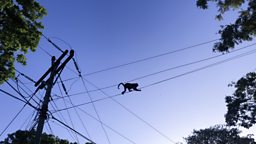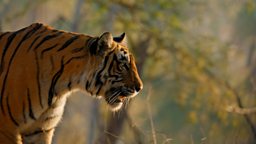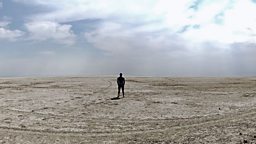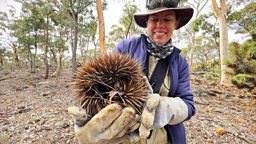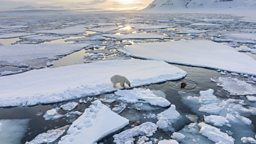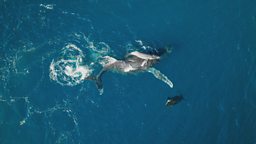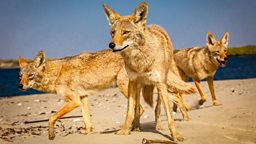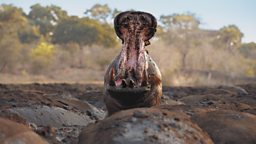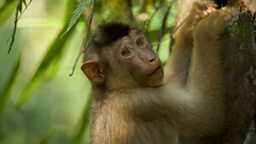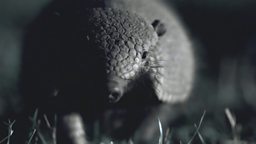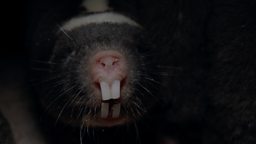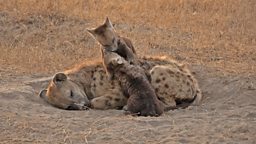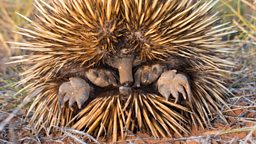Chasing shadows in the vast Sahara
By Tom Parry, Researcher for Mammals
Fennec Foxes are the quintessential desert creature.
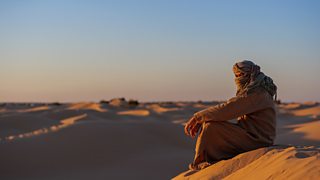
They can live their whole lives in the hottest and driest place on Earth without drinking a drop of water, surviving only on moisture in the small insects, reptiles and burrowing mammals they feed on. In fact, in the whole world, they can be found only in the Sahara. Their cunning is legendary, and their huge ears make them instantly recognisable, but few have seen one in the wild and even fewer can claim to have watched their antics.
At just 20cm tall and weighing no more than 1.5kg, they are also the smallest wild dogs in the world. “The size of a shoe”, wildlife photographer and Fennec fox expert, Bruno D’Amicis told us.
Finding these intriguing little things seemed a daunting prospect as we set out into the vastness of the Sahara Desert. Yet with hundreds and hundreds of miles of golden sand stretching out before us, the size of our target wasn’t our biggest challenge – Fennec foxes are also among the shyest dogs on the planet and almost entirely nocturnal.

We drove in convey for many hours before we reached our destination. We had chosen a spot with an ancient water source nearby, where Bruno had previously had success in photographing the elusive little foxes. We setup camp and settled down for our first night in the Sahara, before the strangest thing happened – it rained!
It’s not rained here for yearsBruno D’Amicis
“It’s not rained here for years” our hosts joked, although perhaps they shouldn’t have been surprised that a British contingent would bring such weather with them. The brief spell of rain was too short to mitigate the longstanding drought in the area, but it was a great stroke of luck for us. It wiped away old tracks and created a new canvas in the sand for us to begin our detective work. We set out the following morning and sure enough we found an array of tiny, delicate paw prints – the foxes were here! We set to work straight away.
It soon became clear that we would rely heavily on the incredible fieldcraft of Bechir Belhadj and the rest of our amazingly knowledgeable Tunisian hosts. Their ability to read the landscape was invaluable, and under Bechir’s guidance and Bruno’s intuitions we placed our remote cameras and set up filming hides, into which camera operators Marco and Pete climbed as night fell and the landscape was transformed.

Our aim was to capture these canids using their remarkable hearing to detect their food. So sensitive are the enormous ears of the Fennec fox that they can hear a pin drop hundreds of metres away and even detect the movement of their prey under the surface of the sand. But this presented another challenge to a film crew - as we sat scanning the horizon with thermal scopes, even the tiniest rustle of clothing would give us away.
even the tiniest rustle of clothing would give us away
There were technical challenges too. The ambition was a scene filmed entirely under moonlight, but there’s no getting around the fact that the moon doesn’t produce as much light as the sun! Working in such conditions meant an array of specialist cameras and lenses.
As night fell over the Sahara, temperatures plummeted to below zero and I was surprised to wake up and find a blanket of frost covering the sand. Bruno had warned us how hostile this environment can be, having been trapped for days sheltering from severe sandstorms, so he assured us that if a few chilly nights and frosty morning were all we had to contend with, we were looking good.
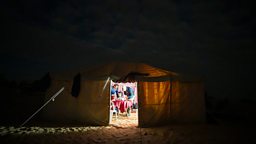
And so the shoot became about perseverance. With limited success at first, the crew stuck with it – and as the days ticked by into weeks, slowly these foxes came to accept us, giving us the opportunity to watch these beautiful animals roam free in their unique environment.
Deep down we all knew something didn’t sit right
Under the moonlight they darted around, skimming over the dunes like something out of Star Wars, scanning the sand’s surface all the while with those like metal detectorists. And we came to know them in return. We named one “Floppy” after its droopy ear. We began to learn their nightly routines. After initially thinking we’d set ourselves an impossible task, we started to understand the place and its inhabitants better, and started to feel hopeful that we could get something here.
Then, one night, everything changed. After weeks of slowly chipping away, spending more and more lovely moments with these incredible nocturnal wonders, suddenly it all went quiet. With every morning that followed a night of staring into empty darkness we dwelled and deliberated over what was going wrong, getting increasingly desperate. Deep down we all knew something didn’t sit right – the foxes had simply disappeared. Finally, after a week without activity, we decided to venture out from our camp and investigate. A few miles away we found the remains of an abandoned hunting camp, and within it a shocking discovery.
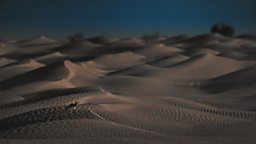
When we set out to film one of the world’s shyest mammals, we knew we’d face a lot of challenges - but none of us had seen this coming. Here were the very foxes we had been hoping to bring to the screen; trapped, skinned and discarded. The delicate little paws that had been making those beautiful tracks in the sand severed and thrown aside next to cigarette butts, crisp packets and other litter.

it felt like losing an old friendBruno D’Amicis
Apparently the meat of Fennec foxes is considered to have magical properties by some, but more likely was that these foxes were victims of a leisure activity for local teenagers. I was overwhelmed by the sheer futility of it and was surprised to find myself succumb to tears. We’d come to love these little desert companions as they had slowly learnt to accept us, and as Bruno bitterly said, “it felt like losing an old friend’.
I used to think of the Sahara as a kind of barren wasteland, a hostile place devoid of life. I now realise how naïve that was. Like every ecosystem on Earth, the Sahara is a beautiful and delicate balance of nature. Desert ecosystems host surprisingly high biodiversity and, because they have adapted specifically to the harsh conditions, their resident species are often found nowhere else. Our short months living in one tiny corner of the Sahara had barely touched the surface of this incredible place.
Given it is largely undeveloped, I had also assumed the Sahara remained a haven for those creatures hardy enough to make a living there – again, how wrong I was. This ecosystem is as fragile as any on Earth and, in fact, it is one of the most persecuted. The most comprehensive study conducted of the area has found that 10 of the Sahara’s 14 largest mammals are now extinct or endangered. “While global attention has been focused on hotspots, the world’s largest tropical desert, the Sahara, has suffered a catastrophic decline in megafauna”, the authors concluded. Durant et al. (2013).
Animals like the Addax antelope, the Dama gazelle, the Saharan cheetah – which have perfectly adapted to the harsh climate, the scarcity of water, even the colours of the Sahara over millions of years – now risk being lost altogether in the space of a generation.
There are many of reasons for this catastrophic decline. As we witnessed first-hand, hunting and illegal trade are widespread across the Sahara and this has decimated populations of prey and the predators that depend on them. This is then greatly exacerbated by the political instability across many Saharan countries, which hugely hampers those few conservation efforts that do manage to secure funding. Unrelenting off-road tourism is encroaching even the quietest corners, and overgrazing and charcoal production threatens the last green oasis. Above all, the prospect of severe drought, caused by climate change, is speeding up the desertification of semi-desertic regions affecting local people. As always, behind an issue there are many causes.
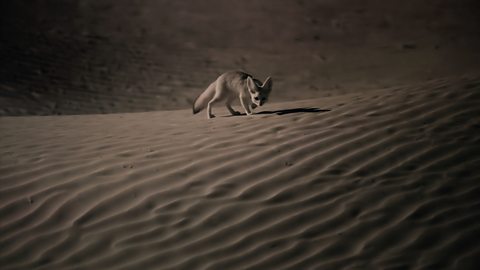
Listening for food in the Saharan Desert
The Fennec fox uses its large ears to find prey above and below the sands of the desert.


